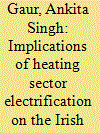| Srl | Item |
| 1 |
ID:
186496


|
|
|
|
|
| Summary/Abstract |
Electrifying the heating sector, which is energy and carbon intensive, and shifting electricity supply to renewable technologies is one of the main policy options being pursued for decarbonisation of the heating sector. Heat pumps are widely adopted for this purpose. However, the impact of this policy on existing electrical systems, both from the perspectives of supply and demand, is understudied in the literature. This paper examines the system-wide impacts of integrating high quantities of heat pumps, in line with government targets, in Ireland. We provide a broad discussion of the ramifications of heating sector electrification in terms of system costs and expansion planning under renewable energy targets. Results reveal significant changes in generation and increases in associated costs with increasing levels of electrification. On the flip side, the heating sector electrification leads to more efficient utilisation of renewable energy and the transmission network. We also explore alternative policy pathways to minimize impacts on the system. These include determining optimal locations for heat pump integration and a technology-neutral emission reduction target. Optimal distribution of heat pumps has a low impact on system metrics whereas pursuing an emission reduction target makes a large impact on system costs.
|
|
|
|
|
|
|
|
|
|
|
|
|
|
|
|
| 2 |
ID:
166703


|
|
|
|
|
| Summary/Abstract |
We present a computationally-efficient optimization model that finds the least-cost generation unit expansion, commitment, and dispatch plan to serve hourly electricity demand and ancillary service requirements. We apply the model to a case study based on data from the electricity market in Texas (ERCOT) to analyze the market and investment impacts of several incentive mechanisms that support variable renewable energy (VRE) investments and carbon emission reductions. In contrast to many previous studies, the model determines least-cost VRE investments under different cost and incentive assumptions rather than analyzing scenarios where VRE expansion is pre-determined. We find that electricity prices can vary significantly under different incentive mechanisms, even when comparable generation portfolios result. Therefore, the preferred incentive mechanism depends on stakeholder objectives as well as the prevailing electricity market framework. Our results indicate that a carbon tax is more system cost-efficient for reducing emissions, while production and investment tax credits are more system cost-efficient for increasing VRE investments. Similarly, incentive mechanisms that reduce electricity prices may increase the need for separate revenue sufficiency mechanisms (e.g. a capacity market) more than a policy that increases electricity prices. Moreover, the impacts on consumer payments are not always aligned with changes in system costs. Overall, the analysis illustrates the importance of considering electricity market impacts in assessing the economic efficiency of VRE and carbon incentive mechanisms.
|
|
|
|
|
|
|
|
|
|
|
|
|
|
|
|